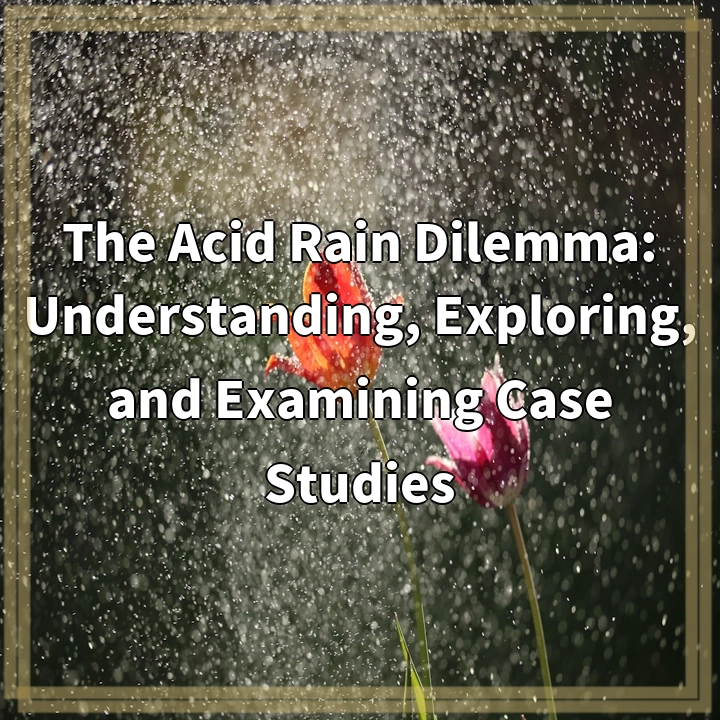
What is Acid Rain?
Acid rain is a type of environmental pollution that occurs when acidic gases and particles, such as sulfur dioxide (SO2) and nitrogen oxides (NOx), are released into the atmosphere and react with water vapor, oxygen, and other compounds to form acids. These acids then fall back to the earth’s surface in the form of rain, snow, fog, or dry particles.
Real-World Problems Associated with Acid Rain:
1. Damage to Ecosystems:
Acid rain can have detrimental effects on aquatic and terrestrial ecosystems. When acid rain falls on forests, lakes, and rivers, it can damage plants, trees, and aquatic organisms, disrupt the delicate balance of ecosystems, and even lead to the loss of biodiversity. It can also contribute to the acidification of soils, making them less fertile and inhibiting plant growth.
2. Harm to Human Health:
Acid rain is not only harmful to the environment but can also pose risks to human health. Fine particles and toxins released from the combustion of fossil fuels and industrial activities can be carried by acid rain and inhaled by humans. This can result in respiratory problems, such as asthma and bronchitis, and can worsen existing lung conditions.
3. Corrosion of Infrastructure:
The acidic nature of acid rain can cause damage to infrastructure and buildings over time. Acid rain can erode materials like metal, stone, and paint, leading to structural weakening, discoloration, and the need for costly repairs and maintenance. This impacts not only the aesthetic appeal of structures but also their safety and longevity.
4. Impact on Agriculture:
Acidic rainwater can directly harm crops and agricultural lands, impacting food production and yield. Acid rain can leach valuable nutrients from the soil, making it less fertile and affecting crop growth. It can also damage leaves, stems, and root systems, making plants more susceptible to diseases and pests.
5. Transboundary Effects:
Acid rain does not respect borders and can travel long distances through air and water currents. This means that areas far away from the original source of pollution can still experience the damaging effects of acid rain. Transboundary pollution from neighboring countries or regions can make it more challenging to address the issue effectively, requiring international cooperation and coordination.

Solutions to Acid Rain:
1. Reducing Emissions:
One of the most effective solutions to combat acid rain is to reduce the emissions of sulfur dioxide (SO2) and nitrogen oxides (NOx) from industrial activities, power plants, and vehicles. Implementing stricter pollution control measures, such as installing scrubbers on smokestacks and using cleaner fuel technologies, can significantly reduce acid rain-causing emissions.
2. Implementing International Agreements:
Addressing the issue of acid rain requires international cooperation. Governments can work together to develop and implement treaties and protocols aimed at reducing acid rain pollution. For example, the Acid Rain Program in the United States and the Gothenburg Protocol in Europe have played a significant role in reducing sulfur and nitrogen emissions.
3. Promoting Renewable Energy:
Transitioning to cleaner and renewable energy sources, such as solar, wind, and hydroelectric power, can help reduce the reliance on fossil fuels and their associated emissions. By shifting towards sustainable energy options, we can decrease the release of pollutants that contribute to acid rain formation.
4. Educating and Raising Awareness:
Education and awareness campaigns play a crucial role in addressing the issue of acid rain. By increasing public knowledge about the causes, impacts, and solutions of acid rain, individuals can make informed choices that contribute to reducing pollution. This includes practicing energy conservation, supporting environmentally friendly policies, and advocating for change.
5. Restoring Affected Ecosystems:
Efforts should be made to restore ecosystems that have been damaged by acid rain. This can involve rehabilitating forested areas, reintroducing native species, and improving the quality of water bodies. Implementing measures to reduce soil acidification and promote ecological recovery can help ecosystems regain their resilience and functionality.















